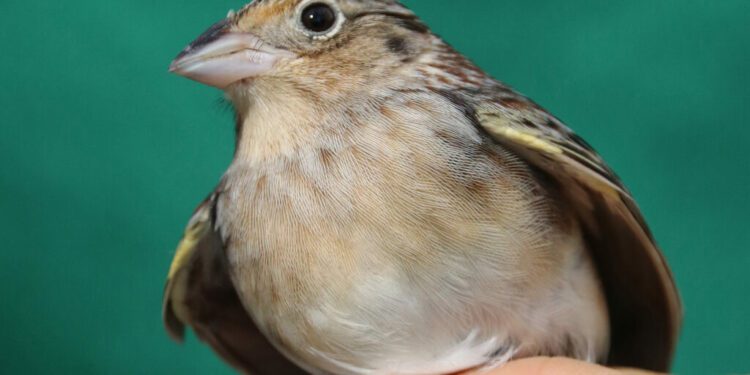Explore the latest news about what’s at stake for the climate during this election season.
When conservationists rescued Florida grasshopper sparrows eight years ago from failing or flooded nests, they ended a long debate over whether taking sparrows for captive-breeding might push their wild population closer to the brink.Â
Other breeding programs involving larger, longer-living birds such as the California condor had been successful, but there was no precedent for a species like the Florida grasshopper sparrow, which weighs no more than five or six pennies and lives a mere three to five years.
“This was important because it was a short-lived grassland bird, and grasslands in general in North America are declining a bit because it’s a place where people develop,” said Robert Aldredge, Florida Air Force partnership coordinator at the U.S. Fish and Wildlife Service. “It’s a good place to have farmlands, so grasslands species are not doing the best.”
The sparrows were housed at facilities like White Oak Conservation outside of Jacksonville and the Brevard Zoo on the Space Coast, where their caretakers maintained conditions within their enclosures that closely mimicked those on the prairie. No one knew whether the sparrows would survive, and when they did, no one knew whether they would breed and raise young. Then no one knew whether the young would survive in the wild, and when they did no one knew whether this generation would breed and raise young.
“It was a lot of difficult and very strong feelings, and no one really knew the answer,” Gray said.
The captive-raised sparrows have surpassed expectations in the wild. When conservationists began releasing them in 2019, another step that came after agonizing debate, they hoped at least 15 percent would survive beyond a year and breed with wild sparrows. Initially 20 percent survived and bred, and since then the birds have maintained a 15 percent survival rate, considered a success for a species that never had a high survival rate to begin with.
“It is wonderful news that they have been able to successfully recruit into the population,” Fitzwilliam said. “Their offspring are just like the other sparrows.”
“There was some concern in the beginning of the program, whether the birds would be the same caliber breeders because they were raised in captivity,” she said. “But they have been a huge asset in keeping the population basically from winking out.”
The next step will be getting enough captive-raised birds onto the prairie so that the population can become self-sustaining, Gray said.
“How do we get enough birds out there, and will it be self-sustaining?” he asked. “That is what keeps me awake.” Â
Fitzwilliam said that while the Florida grasshopper sparrow still faces many threats, the population has stabilized to the point where conservationists can turn their attention toward other issues, such as how the landscape itself can be improved, through fire for instance.“There were a lot of exercises where we imagined the very worst case scenario,” she said. “What we have achieved is the best case scenario. The birds are able to settle. They are able to breed. They are able to contribute to the population. So that piece of the puzzle, it’s very exciting that it’s working out well.”
About This Story
Perhaps you noticed: This story, like all the news we publish, is free to read. That’s because Inside Climate News is a 501c3 nonprofit organization. We do not charge a subscription fee, lock our news behind a paywall, or clutter our website with ads. We make our news on climate and the environment freely available to you and anyone who wants it.
That’s not all. We also share our news for free with scores of other media organizations around the country. Many of them can’t afford to do environmental journalism of their own. We’ve built bureaus from coast to coast to report local stories, collaborate with local newsrooms and co-publish articles so that this vital work is shared as widely as possible.
Two of us launched ICN in 2007. Six years later we earned a Pulitzer Prize for National Reporting, and now we run the oldest and largest dedicated climate newsroom in the nation. We tell the story in all its complexity. We hold polluters accountable. We expose environmental injustice. We debunk misinformation. We scrutinize solutions and inspire action.
Donations from readers like you fund every aspect of what we do. If you don’t already, will you support our ongoing work, our reporting on the biggest crisis facing our planet, and help us reach even more readers in more places?
Please take a moment to make a tax-deductible donation. Every one of them makes a difference.
Thank you,
Amy Green
Reporter, Florida
Amy Green covers the environment and climate change from Orlando, Florida. She is a mid-career journalist and author whose extensive reporting on the Everglades is featured in the book MOVING WATER, published by Johns Hopkins University Press, and podcast DRAINED, available wherever you get your podcasts. Amy’s work has been recognized with many awards, including a prestigious Edward R. Murrow Award and Public Media Journalists Association award.
Source link : http://www.bing.com/news/apiclick.aspx?ref=FexRss&aid=&tid=66dc1fc9fdad44f89df1de9297102335&url=https%3A%2F%2Finsideclimatenews.org%2Fnews%2F07092024%2Fflorida-grasshopper-sparrow-fights-extinction%2F&c=6361985868602609432&mkt=en-us
Author :
Publish date : 2024-09-06 22:05:00
Copyright for syndicated content belongs to the linked Source.














